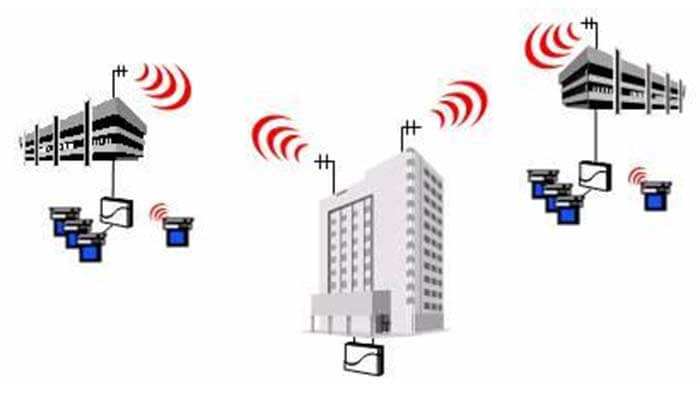WMAN definition
Wireless Metropolitan Area Network (WMAN) refers to a locally distributed wireless network that transmits information between distributed nodes that cover the city and its suburbs. It can realize multi-business access services such as voice, data, image, multimedia, and IP.
In April 2002, the 802.16 wireless metropolitan area network standard was adopted. European ETSI has also formulated a similar wireless metropolitan area network standard HiperMAN.
WMAN can provide last-mile broadband wireless access (fixed, mobile and portable).
In many cases, a wireless metropolitan area network(WMAN) can be used to replace the existing wired broadband access, so it is sometimes called a wireless local loop.
WMAN technologies
The typical value of WMAN coverage is 3~5km, and the coverage of point-to-point links can be as high as tens of kilometers. It can provide the ability to support QoS and the shared access capability with a certain range of mobility. Technologies such as MMDS, LMDS and WiMAX belong to the category of metropolitan area networks.
LMDS technology in WMAN
LMDS is point-to-multipoint broadband fixed wireless access technology.
It can provide a very high bandwidth to realize two-way data transmission, and on this basis, promote a variety of broadband interactive data and multimedia services to meet user requirements for high-speed data and image communication. Usually, the operating frequency of the system is 10~43GHz, and the spectrum bandwidth available near the 26GHz frequency band can reach more than 1GHz.
The LMDS network organization adopts a service area structure similar to a honeycomb, which divides an area that needs to provide business services into several service areas, which can overlap each other.
According to needs, a service area can be further divided into different sectors to provide different services for different sectors. A base station is set up in each service area to communicate with fixed users in the service area via a point-to-multipoint wireless link. The coverage area of each base station is about 5km.
The LMDS downlink uses TDMA to transmit signals to the coverage area, and each user terminal receives its own information in a specific frequency band. The uplink adopts TDMA or FDMA mode.
The outdoor unit of the base station includes two parts, a radio frequency transceiver and a radio frequency antenna. The radio frequency transceiver is responsible for up-converting and modulating the intermediate frequency signal from the indoor unit to the radio frequency, and transmitting the radio frequency signal. At the same time, the received radio frequency signal is down-converted and transmitted to the indoor unit, thereby realizing two-way data between the central base station and the terminal Communication.
Because LMDS uses the 26GHz frequency band, the communication term between the central base station and the terminal is the category of line-of-sight transmission.
MMDS technology in WMAN
MMDS is a new type of wireless access technology developed in recent years to transmit cable TV signals through wireless microwaves.
The system composed of this technology is light in weight and small in size, convenient for installation and commissioning, and is very suitable for small and medium-sized cities or areas where cable TV coverage is not available.
The operating frequency used by the system is generally 2.5~3.5GHz, so that people can directly transmit 100 sets of digital TV program signals to users within 50km of the transmitting antenna. It can be seen that only one transmission tower can cover a medium-sized city.
One of the most notable features of MMDS is that the local oscillator point of the downconverter can be different and can be selected by the user. Therefore, the signal after downconversion can fall in the VHFI and III frequency bands of the TV standard channel respectively, supplementing the A and B frequency bands, UHF 13~45CH (frequency band), which is convenient to avoid the frequency band occupied by local open-circuit wireless TV or CATV.
WiMAX technology in WMAN
WiMAX (Worldwide Interoperability for Microwave Access) is a technical standard for wireless broadband access to metropolitan area networks.
This technology can provide interoperability in a point-to-multipoint environment, and then wirelessly access the Internet. WiMAX can provide fixed, mobile, and portable wireless connections, and can realize high-speed information interaction with the base station through the transfer of other user stations.
The coverage range can reach 50km, and the maximum data rate can reach 75Mbit/s. It can be regarded as an extension of NGN. It can simultaneously support more than 60 regional users connected by TI and hundreds of home users connected by DSL through a single base station.
Generally, a base station can be divided into 6 sections at most. Compared with Wi-Fi technology, it can provide better scalability and security, so as to achieve carrier-class multimedia services, and the construction cost is low.
WiMAX is often used to mean wireless metropolitan area network WMAN, which is similar to Wi-Fi used to mean wireless local area network WLAN.
IEEE’s 802.16 working group is the maker of wireless metropolitan area network standards, and the WiMAX Forum is the promoter of 802.16 technology.
Two official WiMAX standards:
802.16d (its official name is 802.16-2004), is a fixed broadband wireless access air interface standard (2 ~ 66 GHz frequency band).
The enhanced version of 802.16, namely 802.16e, is a broadband wireless access air interface standard (2 ~ 6 GHz frequency band) that supports mobility, and it is backward compatible with 802.16-2004.
You may also be interested in the below articles.




